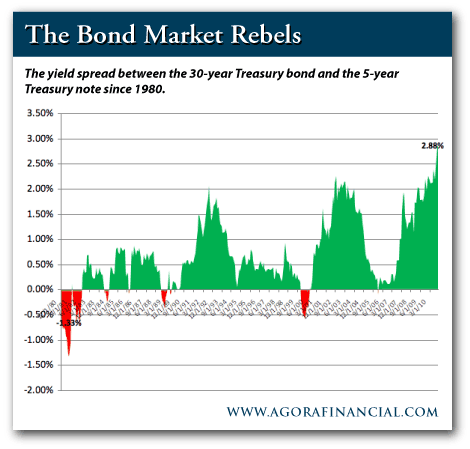The Long and Short of Treasury Bond Yields
“Prices are liars,” says Passport Capital’s investing ace, John Burbank.
But even liars sometimes tell the truth. Trying to discriminate between the liars and the truth-tellers is every investor’s most essential – and most difficult – task. Some bull markets are the real deal; others are simply bear markets that would fail a polygraph test.
Consider some of the bull markets of the moment… Stocks, gold, bonds, grains, oil, Chinese real estate and Sarah Palin’s popularity have all been in rally mode for months, if not years.
Which ones are lying? Your California editor has no definitive answers, but he has a few heartfelt guesses…
The truth-tellers: gold, grains and oil. The little-white-liars: stocks and Sarah Palin’s popularity. The pathological liars: Chinese real estate and bonds.
Jim Chanos, the insightful short-seller who has amassed a fortune by identifying – and betting against – fatally flawed companies like Enron and Tyco, considers the Chinese real estate market to be a disaster in the making. “It is Dubai times 1,000…or worse,” says Chanos. “Bubbles are best identified by credit excesses, not valuation excesses. And there’s no bigger credit excess than in China.”
By extension, Chanos believes Chinese stocks are better sold than bought. His arguments are persuasive.
But today’s edition of The Daily Reckoning will not address the validity or fallacy of the bull market in Chinese real estate. Instead, your editors will turn their skeptical gaze toward the bull market in bonds – and in particular, the bull market in Treasury bonds.
The US Treasury market has been rallying – more or less – for the last 30 years. Back in 1981, when then-Federal Reserve Chairman, Paul Volcker, was battling to contain hyperinflation, 30-year bond yields topped 15%. Twenty-seven years later, during the crisis of 2008, the 30-year yield plummeted to an all-time low of 2.55%. Over this identical timeframe, one-year T-bill yields plummeted from a high of 14.93% to a low of 0.19%. That is a bull market!
But a fascinating – and perhaps telling – divergence has developed between the 30-year yield and short-term Treasury yields: the 30-year yield is climbing, short-term yields are not…at least not very much. As a result the yield curve – i.e. the spread between long- and short-term rates – has reached its steepest level in three decades.

To express this divergence a little differently, the 30-year yield hit its all-time low two years ago, and has soared from 2.55% to 4.17%. The one-year yield hits its all-time low two weeks ago, and has barely budged since then.
According to dusty, old economics textbooks, a rapidly steepening yield curve portends resurgent inflation. But according to the esteemed academic, Ben Bernanke, a steepening yield curve is a sign that his battle against deflation is “succeeding.” We trust the textbooks more than the academic…especially because the academic insists on fighting an enemy that he, alone, can see.
Most of the educated world considers the threat of deflation to be as real as the threat of fire-breathing dragons. Nevertheless, Ben Bernanke, our well-intentioned knight, draws his shimmering QE2 from its sheath and strides into the T-bond market to vanquish his mythological enemy.
Ben’s quest will certainly “succeed,” but he will probably lop off the head of the bond market in the process.
Remember, prices are liars. And in the Treasury bond market, the short end of the curve can lie much more easily than the long end, thanks to Bernanke’s QE2 campaign. Because Bernanke’s bond-buying quest is focusing on the short end of the curve, he is distorting prices. “The Federal Reserve’s plan to buy $600 billion of US government debt will focus about 86 percent of its purchases in notes due in 2.5 years to 10 years,” Bloomberg News relates, “leaving the so-called long bond as the security that most closely reflects expectations for inflation.”
“We live in a time in which market distortions are higher than usual,” our colleague Chris Mayer observes. “This thought really hit me when I saw something that I probably never should have seen: For the first time ever, the rate on 30-year mortgages slipped below that of 30-year Treasury bonds. In effect, the market was saying that an individual looking to borrow against his home is a better credit risk than the US government.”
This “market distortion,” Chris explains, is the direct result of the Fed’s meddling at the short end of the curve.
“The usual spread between 30-year mortgages and the 30-year Treasury bond has been around 1.3 percentage points in recent years,” says Chris. “Therefore, assuming the Fed can’t continue its manipulations forever, it’s a good bet that mortgage rates will rise after QE2 wraps up.”
It’s also a pretty good bet that long-term rates will continue rising as Bernanke’s deflation-fighting escapade “succeeds.”


Comments: